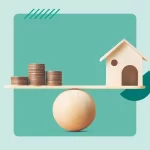
Financial independence is an achievable goal that can be reached by paying off debt and saving money, becoming aware of your spending habits, and taking measures to change them.
Tracking spending and creating a budget to help stay on track are both key components to staying debt free, but using the snowball method for eliminating debt such as mortgage and credit card balances may also prove effective.
1. Know Your Starting Point
As part of your debt reduction journey, it’s essential that you recognize that there are different forms of debt and that it’s perfectly normal to carry both good and bad debt. Good debt would generally include student loans or mortgages that help increase income or build wealth while bad debt such as credit card balances may compromise financial health due to high interest rates.
Start by writing down everything that is owed to you – debt balances, interest rates and minimum monthly payments – in order to establish your debt-to-income ratio – the ratio measures the ratio between what is owed to you compared to what income comes in; ideally this number should be as small as possible.
2. Track Your Spending
Debt-free living is achievable, but requires time and determination. This comprehensive ebook shows you how to develop a budget, cut expenses, increase income and pay off debt quickly and efficiently. In addition, there are strategies included here for building emergency savings, retirement planning and long-term wealth.
First, create a comprehensive list of your debts – their balances, minimum payments and interest rates should all be noted here. While this step can be daunting, it’s necessary in order to know where you stand financially.
After making a list of all of your expenses, compare this total against your monthly income–including any income from a second job or tax refunds–to identify expenses you can cut; perhaps by forgoing gym membership altogether and exercising at home instead or selling items through local pawn shops or Craigslist to save money.
3. Prioritize Your Debt
A well-planned debt repayment strategy can speed up the process. Step one should be to compile a list of all of your debts and their associated monthly costs – this should include both revolving balances like credit cards as well as installment debts such as car loans and mortgages.
After you have calculated your expenses each month, calculate how much can go toward debt payments each month. Be sure to account for necessities like food, utilities and childcare as well as nice-to-haves like technology upgrades or vacations.
Once you know how much you can afford to put toward debt each month, determine which debt to focus on first. According to experts, they typically advise prioritizing those with the highest interest rates as this helps save money in interest charges.
4. Eliminate Debt
People often focus on debt reduction without saving any money, but diverting all your income towards paying down credit card balances could prevent you from reaching other financial goals such as contributing to a 401(k), workplace retirement plan or emergency fund. Instead, Grant Sabatier of Millennial Money advises paying down bad debt first such as morning coffee purchases or sneaker purchases before moving onto more straightforward opportunities such as student loans and mortgages.
He recommends employing either the snowball or avalanche methods of debt elimination to combat your debts. With each method, prioritizing paying off smaller debts first creates a sense of accomplishment and motivation to tackle larger ones while the latter focuses on eliminating those with higher interest rates first as it could save more money overall.
5. Save Money
To truly become debt-free, it’s also necessary to start saving for future needs such as retirement or unexpected expenses. Therefore, setting savings goals and tracking your progress are critical components.
Use one of the budget apps mentioned above or make your own spreadsheet to compare how much you’re spending on essential needs like rent, utilities, and debt payments with how much income is coming in. Once complete, this exercise should help provide a clear picture of where costs can be cut without dramatically altering your life.
Try eating in more often, skipping Happy Hour and making coffee at home rather than visiting a coffee shop – these small changes will soon add up and set you on the path toward financial freedom. Furthermore, having money saved and emergency funds in place makes saving even easier!









